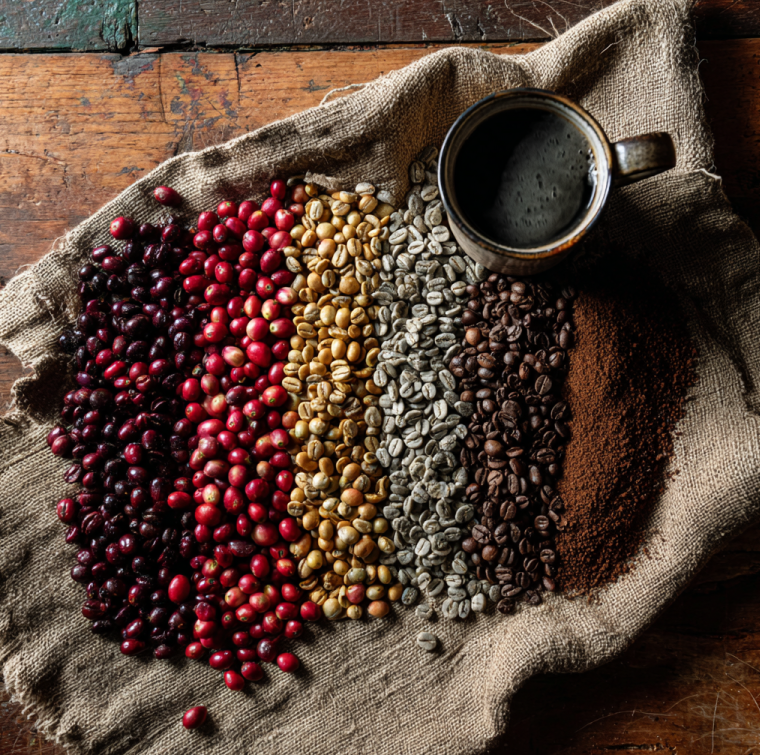Embarking on coffee’s full journey changes how you taste it. A cup stops being “just coffee” the moment you see the chain of patient decisions behind it, soil and altitude, the timing of a harvest, a roaster’s heat curve, your grind and water. That’s why at Headcount Coffee we built the Profiled Pour Experience: we take your flavor notes and build a roast to match. But first, let’s follow a single cherry all the way home.
The Origin: Seeds of Flavor
The story starts inside the Coffee Belt, between the Tropics of Cancer and Capricorn, where mist and sunlight trade places all day long. Terroir, soil, climate, and elevation, acts like a dial on flavor. Ethiopia’s highlands whisper florals and stone fruit; Central America’s volcanic slopes lean into cocoa, caramel, and citrus. Even before a cherry blushes red, its future cup is being written by the hillside beneath it.
Cultivation & Harvest: Choosing Ripeness Over Speed
A coffee tree spends years learning patience. It blossoms with jasmine-like flowers, then takes roughly nine months to mature fruit. Peak production doesn’t rush; it arrives around the fifth year. On the branch, cherries ripen in little galaxies; the best farms pick selectively, returning to the same trees again and again to take only the ripe. Hand-picking trades speed for precision, protecting sweetness and balance that bulk harvests often blur.
Processing: Turning Fruit into a Green Bean
Processing is where the cup’s personality sharpens. Freshly picked cherries must become stable seeds, and how that happens sets the tone:
Natural (Dry): Whole cherries dry in the sun for weeks, fruit sugars lingering against the seed. Results: fuller body, round sweetness, fruit-forward character.
Washed (Wet): Fruit is pulped away; a short fermentation removes the sticky mucilage before rinsing and drying. Results: clean lines, brighter acidity, clear origin notes.
Honey: Pulp off, some mucilage on, then slow drying. Results: a middle path, silky body and lifted sweetness without the wildness of full naturals.
Drying, Milling & Sorting: Quiet Work You Can Taste
Beans dry to ~11% moisture, by sun when weather allows, or by careful mechanical heat when it doesn’t. Then parchment is hulled, and seeds are graded for size, density, and color. Evenness here pays off later: consistent sieves roast more predictably and brew more reliably.
Roasting & Cupping: Where Sugar Meets Heat
Green coffee is all potential; roasting is the reveal. As temperature climbs, water flashes to steam, CO₂ builds, and the Maillard reaction knits sugars and amino acids into aromatic browns, bread crust, caramel, chocolate, spice. Light roasts spotlight origin; medium balances sweetness, body, and clarity; darker roasts trade origin nuance for roast-driven cocoa and smoke. Cupping, the industry’s side-by-side tasting, keeps the compass set, confirming the profile that best expresses a lot before it ever reaches your grinder.
Brewing: The Last Few Inches
Now it’s your turn. Grind size is extraction’s throttle; water temperature and contact time are the road. Coarse grinds linger for French press and cold brew; medium to medium-fine snaps pour-overs into focus; fine and precise unlock espresso’s syrup and crema; Turkish goes powder-fine and unfiltered. Calibrate, taste, adjust. That’s the craft you control.
Make the Journey Yours
Tell us how you like to taste, fruit or chocolate, bright or deep, and we’ll roast to your spec with our Profiled Pour. Or browse what’s fresh:
Shop All Coffee → Headcount Coffee Collection
Related Reads
- Coffee Grind Types Uncovered — dial in flavor from cold brew to Turkish.
- The Legend of the Dancing Goats — the origin tale that still makes us smile.

0 comments